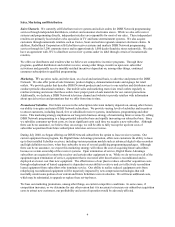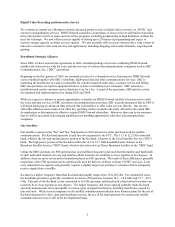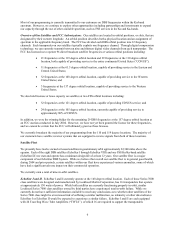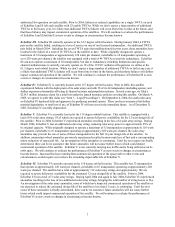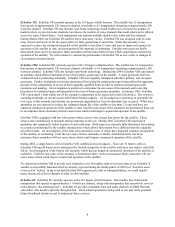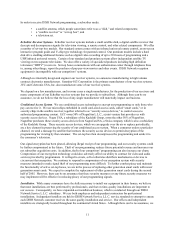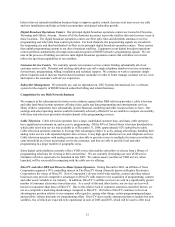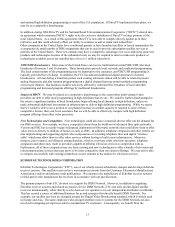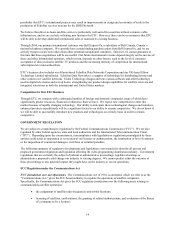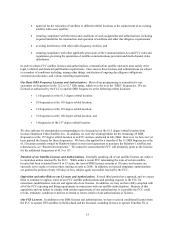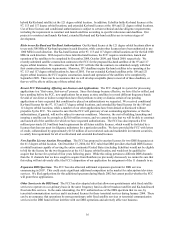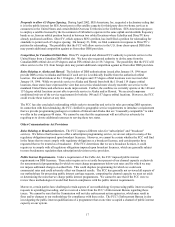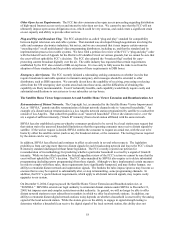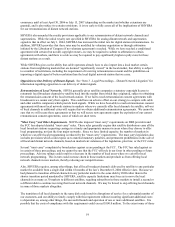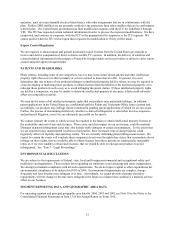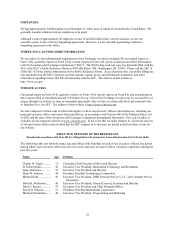Dish Network 2004 Annual Report Download - page 21
Download and view the complete annual report
Please find page 21 of the 2004 Dish Network annual report below. You can navigate through the pages in the report by either clicking on the pages listed below, or by using the keyword search tool below to find specific information within the annual report.13
and national high definition programming to most of the U.S. population. If DirecTV implements these plans, we
may be at a competitive disadvantage.
In addition, during 2004 DirecTV and the National Rural Telecommunications Cooperative (“NRTC”) entered into
an agreement which terminated NRTC’s rights to be the exclusive distributor of DirecTV in large portions of the
rural United States. As a result of this agreement, DirecTV is now able to compete directly against us in these
territories, and this could adversely affect our ability to continue to add or retain rural subscribers.
Other companies in the United States have conditional permits or have launched satellites or leased transponders for
a comparatively small number of DBS assignments that can be used to provide subscription satellite services to
portions of the United States. These new entrants may have a competitive advantage over us in deploying some new
products and technologies because of the substantial costs we may be required to incur to make new products or
technologies available across our installed base of over 11 million subscribers.
VHF/UHF Broadcasters. Most areas of the United States can receive traditional terrestrial VHF/UHF television
broadcasts of between 3 and 10 channels. These broadcasters provide local, network and syndicated programming.
The local content nature of the programming may be important to the consumer, and VHF/UHF programming is
typically provided free of charge. In addition, the FCC has allocated additional digital spectrum to licensed
broadcasters. At least during a transition period, each existing television station will be able to retain its present
analog frequencies and also transmit programming on a digital channel that may permit multiple programming
services per channel. Our business could be adversely affected by continued free broadcast of local and other
programming and increased program offerings by traditional broadcasters.
Impact of HDTV. We may be placed at a competitive disadvantage to the extent other multi-channel video
providers are able to offer more programming in high definition than we are. We could be further disadvantaged to
the extent a significant number of local broadcasters begin offering local channels in high definition, unless we
make substantial additional investments in infrastructure to deliver high definition programming. While we expect
that we would be able to use a portion of our planned increase in satellite capacity to respond to some of these
competitive threats, there can be no assurance that we will be able to effectively compete with high definition
program offerings from other video providers.
New Technologies and Competitors. New technologies could also have a material adverse effect on the demand for
our DBS services. For example, we face a competitive threat from the build-out of advanced fiber optic networks.
Verizon and SBC have recently begun widespread deployment of fiber-optic networks that could allow them to offer
video services directly to millions of homes as early as 2006. In addition, telephone companies and other entities are
also implementing and supporting digital video compression over existing telephone lines and digital “wireless
cable” which may allow them to offer video services without having to build a new infrastructure. Moreover,
mergers, joint ventures, and alliances among franchise, wireless or private cable television operators, telephone
companies and others may result in providers capable of offering television services in competition with us.
Furthermore, all of these companies may use these existing and new technologies to offer a bundle of television and
telecommunications services that may prove to be more competitive than our current offerings. We may not be able
to compete successfully with existing competitors or new entrants in the market for television services.
ECHOSTAR TECHNOLOGIES CORPORATION
EchoStar Technologies Corporation (“ETC”), one of our wholly-owned subsidiaries, designs and develops EchoStar
receiver systems. Our satellite receivers have won numerous awards from the Consumer Electronics Manufacturers
Association, retailers and industry trade publications. We outsource the manufacture of EchoStar receiver systems
to third parties who manufacture the receivers in accordance with our specifications.
The primary purpose of our ETC division is to support the DISH Network. However, in addition to supplying
EchoStar receiver systems and related accessories for the DISH Network, ETC also sells similar digital satellite
receivers internationally, either directly to television service operators or to our independent distributors worldwide.
This has created a source of additional business for us and synergies that directly benefit DISH Network. For
example, our satellite receivers are designed around the Digital Video Broadcasting standard, which is widely used
in Europe and Asia. The same employees who design EchoStar receiver systems for the DISH Network are also
involved in designing set-top boxes sold to international TV customers. Consequently, we benefit from the



